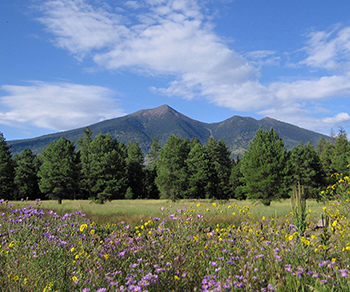Location

San Francisco Peaks. Courtesy of the Flagstaff Convention
and Visitors Bureau
Flagstaff, a small city of 70,000 people, is located in the mountains of northern Arizona at an elevation of 7,000 feet (2,134 meters). The combination of high altitude and low humidity makes the city very comfortable in June; the average high temperature is 80°F or 27°C. It is rich with history, cultural diversity and stunning beauty, creating a most attractive center for visitors from around the world. Since Northern Arizona University is located in Flagstaff, the combination of a university town and a hub of visitor activity makes it an excellent place for a conference with a large selection of fine restaurants and brew pubs. Many restored historical buildings in town give it the feel of the American West in years past.
Flagstaff sits amid some of the most beautiful scenery in the United States. The Grand Canyon, truly one of the most spectacular natural wonders, is only 81 miles (130 Km) away. The largest contiguous Ponderosa pine forest in the world surrounds the city, which is also at the base of the San Francisco Peaks. Mount Humphries, one of the peaks, at 12,633 feet (3,853 meters), is the highest mountain in Arizona. Also nearby is a breathtaking drive which descends through Oak Creek Canyon, a smaller cousin of the Grand Canyon, to the gorgeous Red Rock Country of Sedona, an artist colony. This wealth of natural beauty provides an excellent location for outdoor activities -- skiing in the winter and hiking, mountain biking and horseback riding in the summer.

Hopi Kachina Doll. Photographed by Day
Williams. Copyright Photo Researchers
Throughout the centuries Native American civilizations have flourished in the area around Flagstaff. Just east of the city is Walnut Canyon National Monument where one can walk among the cliff dwellings and pueblos where people lived 800 years ago. At the edge of the city is the Museum of Northern Arizona, which is one of the great regional museums of the world. Here are displays of the geology and archeology of the Colorado Plateau, the lifeways of ancient inhabitants, and the arts and crafts of Navajo, Hopi and Zuni people. The museum shop has an international reputation for selling high quality fine art, jewelry, rugs, pottery, kachina dolls and more.
Located in Flagstaff is the Lowell Observatory where in 1930 Clyde Tombaugh discovered the “dwarf planet” Pluto. You may know that some of his ashes were on the NASA space craft New Horizons which recently flew by Pluto. A variety of programs for the public are offered daily. On clear evenings you may view the moon and planets through the telescopes in the observatory.
Access to Flagstaff by air (FLG) is available by way of six daily connecting flights from the Phoenix Sky Harbor International Airport (PHX). It is also possible, and it may be less expensive, to take a van shuttle between the Phoenix airport and Flagstaff. Make a shuttle reservation here. The cost is $43 per person one way. Amtrak’s Southwest Chief line between Chicago and Los Angeles makes two stops each day in Flagstaff. Two interstate highways, a major east-west Interstate 40 and Interstate 17 from Phoenix, also provide easy automobile access to Flagstaff.
A most enjoyable way to travel to Flagstaff is to fly to the Phoenix airport and rent a car for the two-hour drive. One enters Interstate 17 at the airport, and the highway ends in Flagstaff at Milton Road, the location of the conference center and most of the listed accommodations. This pleasant drive transitions from the Sonoran desert surrounding Phoenix, with its environment of cacti and other desert vegetation, to the high Colorado Plateau, with its forest of Ponderosa pine.
Learn more about Flagstaff by watching this video: